| |
|
 |
|
Karlštejn
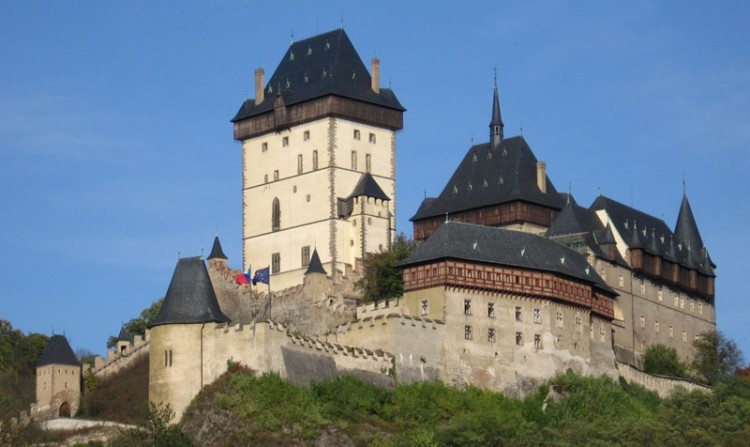 Czech Republic is known in the World as a country with abundant history and unusual number of monuments, which refer on it. It is abundant especially on castles, mainly Gothic. Karlstejn is probably the best known. This castle is located in the middle Bohemia, about 30 km near Prague. The castle lies on tip of steep lime bill in the valley of the river Berounka and more than quarter million of tourists per year visit the castle. Czech Republic is known in the World as a country with abundant history and unusual number of monuments, which refer on it. It is abundant especially on castles, mainly Gothic. Karlstejn is probably the best known. This castle is located in the middle Bohemia, about 30 km near Prague. The castle lies on tip of steep lime bill in the valley of the river Berounka and more than quarter million of tourists per year visit the castle.
Castle structure
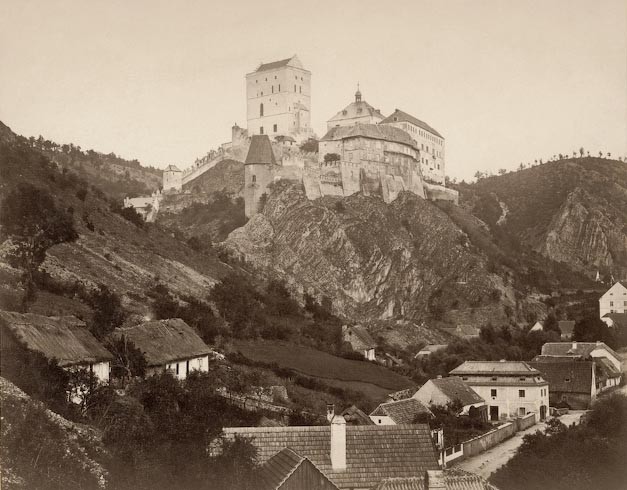 Karlštejn consists of several parts. Central point of the castle is Great Tower, which is located on the highest place of the castle. This tower also hides the biggest wealth as regards interior. Chapel of the holy cross is situated in the second floor, on which account was castle actually built. Crown jewels and holy relics were laid here. Interior of the chapel is moreover decorated by plenty of gems and gold stamping and 127 paintings depicting martyrs by master Theodorik is not missing here. It is the largest set of tableaus in the whole World. Karlštejn consists of several parts. Central point of the castle is Great Tower, which is located on the highest place of the castle. This tower also hides the biggest wealth as regards interior. Chapel of the holy cross is situated in the second floor, on which account was castle actually built. Crown jewels and holy relics were laid here. Interior of the chapel is moreover decorated by plenty of gems and gold stamping and 127 paintings depicting martyrs by master Theodorik is not missing here. It is the largest set of tableaus in the whole World.
Next part of the castle is Marian tower. Noted double-portrait of Chatles IV and Anna Svidnicka is kept here. Charles embeds holy relics into this chapel.
Living part of the castle is called Emperor´s Palace, which served as a ruler´s living palace to Charles IV and Wenceslas IV. First floor was occupied by henchmen and second by ruler himself.
.jpg)
The castle was founded by King of Bohemia and also Holy Roman Emperor Charles IV. The purpose of its building was to build a place, which could serve as a repository for the Crown jewels. But that was not the only purpose of this precious castle. Therewithal it ought to serve as a summer-house and a place for recollection and ruler´s prayers.
Building started in 1348 and was finished after nine years in 1357. The castle lived it´s golden age at that times. Worse time came later. Emperor Sigismund took part of treasure to pay mercenaries in 1420. The Hussites even laid siege to the castle two years later. They used carriage full of dung among others to beat defenders. Even that was to little avail, because the castle resisted. Whereat, conquest of the castle could not be such a complicated problem. The castle doesn´t have its own well and is dependent on water from cistern, which is in well tower, which is 81 meters deep. The water comes there via secret drift from near stream. The castle came through Renaissance adjustment in the next century. It ran through 1578 to 1597 under the lead of Oldřich Aostalis de Sala. The Royal jewels were carried out from castle in 1619, so the castle became to decline. It was even spoilt by Swedish army in 1646. The peak of declining came in 18th century, when it came into private ownership in 1705. Only small part of the castle was maintained and palace actually served as a granary. Two palace´s walls had to be demolished in consequence of that. Karlštejn was in ownership of Noblewomen Institution from 1755. Endeavors to restore the castle its original gothic form were initiated in late 19th century. Reconstruction was started in 1886 under the lead of Mocker. Adjustments were projected in purism spirit and were finished in 1899. However, it encountered many negative feedbacks. As far as time went on, the critics smooth down. The castle has been listed as a National Cultural Monument since 1962.
The castle´s myths
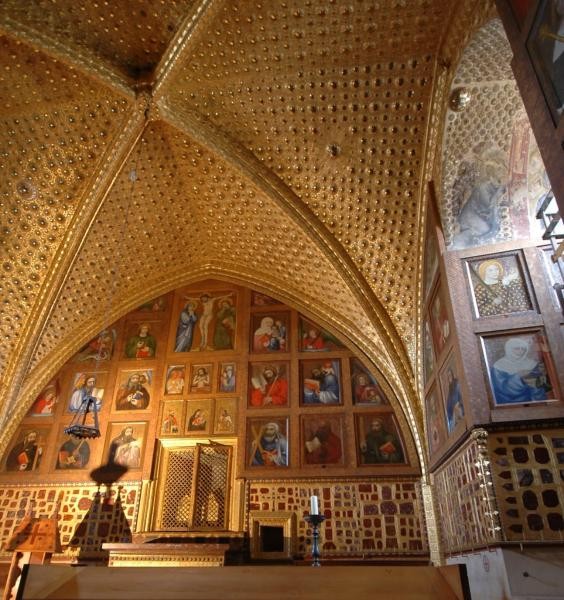 Roman and Czech Crown jewels were hold for a long time in Great Tower at Karlštejn. Entrance to the Chapel of the Holy Cross, which was guarded daily nightly by entire heaven army, was granted only by the Reichstag. It´s no wonder that humble folk saw Karlštejn as a “thirteen chamber” and spin countless gossips about it. Roman and Czech Crown jewels were hold for a long time in Great Tower at Karlštejn. Entrance to the Chapel of the Holy Cross, which was guarded daily nightly by entire heaven army, was granted only by the Reichstag. It´s no wonder that humble folk saw Karlštejn as a “thirteen chamber” and spin countless gossips about it.
Feministic fault at Karlštejn
Once no woman was permitted at Karlštejn – that is handed down till today and many laics believe that. Comedy Night at Karlštejn by Vrchlický though harden them. It is not a truth; women had admission on Karlštejn as well as on any other castle. Mess begun after 16th century due to Václav Hájek from Libočany, who mentioned castle Karlík in his chronicle. Karlík is located near Karlštejn and according to Hájek it had to serve as a dormitory for women, who visited their breeds on Karlštejn during the day. We could find out the truth at foundation charter research, where is written: “We inhibit by this charter to no one at tower, where chapel is situated, to sleep or lie with a women.” Women were moving freely along the castle, only entrance to one floor of the Great Tower, where defenders of the treasure were settled, was forbidden.
Czech Bloody Lady of Čachtice
The most fearsome myth is based on real facts. Kateřina Bechyňová dwelled the castle in 16th century – She was wife of the burgrave and she beastly murdered fourteen people. Sadistic Lady mostly tortured young maids, but also varlets and animals didn´t escape her anger. Servant, who didn´t follow her orders was thrown to dungeon without rope. Cat which tear lace to pieces, was flayed alive by order from Kateřina. Then Karlštejn´s provost Václav Hájek from Libočany warned court in Prague of her spree. Czech Lady of Čachtice was condemned to the death by hunger, whereupon her husband banished Hájek from Karlštejn. “Hájek was banded under horse as a rogue and transferred from Karlštejn to Prague” wrote knight from Čáslav in that time – Václav Halaš. Presiding judge of Prague court died two days after death of Lady Kateřina – that would be the last victim of villainous burgravess? It is said, that murdered maids haunt on the castle as hants.
One of the most famous Karlštejn´s myths is related to a blind musician, who accompanied in every step by his faithful dog used to play the lute on the castle. Prince of Brunswick followed by his perfidious butler was visiting the castle at that time. The butler tried to poison his master. He passed a goblet with poison to prince, but he unsuspecting passed it to singer. Let him drink, when he sang and played so nice whole day. When this common singer was raising the goblet to his lips, his dog jumped at him and drunk the poison, after which he immediately naturally expired. Blind man stroke his lovely fellow for the last time and spoke: “Rare master, that wine was poisoned and had to brought you death.” Musician had not got to know which punishment get the rascally butler. He died on grief a couple of days after his doggie.
Interests in castle´s surroundings.
The Wax museum of Czech history under Karlštejn castle
Opened on 06/21/1999 under one of the most visited Czech castle – Karlštejn. We can find exposition of historical cross section of Czech history and Czech statehood, which learns visitor by nonfiction way with famous characters of Czech history in their period environment. The founder of Karlštejn the king Charles IV greets us in two floors on almost 1000m2. You can find also middle-aged craftsmen, sceneries from Hussies wars, ages of Rudolf II., Napoleonic ages, Maria Theresa of Austria, Joseph I., Czech National revival and in not least line many big names from modern Czechoslovak and Czech history.
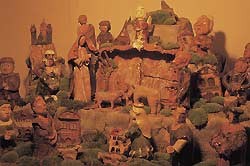 The Crib museum The Crib museum
Started up in 1195 on private cribs and folk art collection basis. High quality old Czech wooden cribs but also cribs from rare materials such as sugar or bread are exhibited here. Three floors of baroque house are equipped with historical furniture, paintings, glass-paintings and wood-carvings. Several mechanical cribs are allurements for kids, most of them can operated by themselves. There are two floors of baroque basements, where is located permanent exhibition of Karlštejn wine growing history. Smell of gingerbread is flown from half of November, because traditional exhibition of gingerbread cribs starts. Gingerbread makers from near surroundings but also more distant places participates each year.
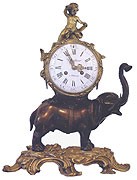
The Clock house on Karlštejn
Sporadic trip of times noting development of watchmaker´s mastery from 16. century to modern period, from Renaissance to Art Noveau.
Collection counting more than 650 exhibits (the most extensive exhibition in Czech republic now) represents clocks from all corners of the World. European “clock” superpowers such as England, France, Switzerland, Germany and Austria-Hungary are mostly represented. We can though find clocks from China, Japan or United States. Timekeeping machines of all types and sizes are showed, from thimbles or wrist chronometers, through alarm clocks, tambour clocks and wall clocks to so called floor clocks and tower clocks. You can get view of pieces from significant and also unknown authors. You will get to know simple wooden mechanisms, but also peals, automatics and most accurate regulators. Clocks from country cottage, burgess households or from chateaus. You will find horological workshop with various machines, instruments and aids, which was until recently absolutely necessary for manufacturing of any type of clocks.
Sources:
[JG,JJ]
Karlštejn - Czech and Slovak Republic - Travel příspěvky
Add your comment, review, features or editorial
|
|
![]()
![]()